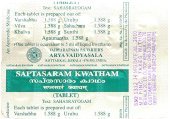Agnimantha, Agni-mantha, Agnimamtha: 15 definitions
Introduction:
Agnimantha means something in Hinduism, Sanskrit, biology. If you want to know the exact meaning, history, etymology or English translation of this term then check out the descriptions on this page. Add your comment or reference to a book if you want to contribute to this summary article.
In Hinduism
Ayurveda (science of life)
Cikitsa (natural therapy and treatment for medical conditions)
Source: Wisdom Library: Ayurveda: CikitsaAgnimantha (अग्निमन्थ) is a Sanskrit word referring to Premna serratifolia, a small tree from the Verbenaceae (verbena) family of flowering plants. Among the botanical synonyms are: Premna integrifolia and Premna obtusifolia. It is used throughout Ayurvedic literature such as the Caraka-saṃhitā. It is a large shrub or small tree growing up to 9 meters in height. The plants grows in the plains throughout India. Its leaves are simple and opposite with small flowers of greenish-yellow or greenish-white color, having a strong odour. The fruits resemble globose drupes. The literal translation of Agnimantha is “producing fire by friction”, and it is composed of the words Agni (‘fire’) and Mantha (‘friction’ or ‘stick’).
This plant (Agnimantha) is also mentioned as a medicine used for the treatment of all major fevers (jvara), as described in the Jvaracikitsā (or “the treatment of fever”) which forms the first chapter of the Sanskrit work called Mādhavacikitsā. In this work, the plant is known as Medā. In this work, the plant is mentioned being part of the Daśamūla group of medicinal drugs.
Kalpa (Formulas, Drug prescriptions and other Medicinal preparations)
Source: Ancient Science of Life: Evaluation of Cyavanaprāśa on Health and Immunity related Parameters in Healthy ChildrenAgnimantha (अग्निमन्थ) refers to the medicinal plant known as Clerodendrum phlomidis, St. Bk., and is used in the Ayurvedic formulation known as Cyavanaprāśa: an Ayurvedic health product that helps in boosting immunity.—Cyavanaprāśa has been found to be effective as an immunity booster, vitalizer and a preventer of day to day infections and allergies such as common cold and cough etc. It is a classical Ayurvedic formulation comprising ingredients such as Agnimantha. [...] Cyavanaprāśa can be consumed in all seasons as it contains weather friendly ingredients which nullify unpleasant effects due to extreme environmental and climatic conditions.
Source: Shodhganga: Edition translation and critical study of yogasarasamgrahaAgnimantha (अग्निमन्थ) refers to the medicinal plant known as “Premna corymbosa Rottl.” and is dealt with in the 15th-century Yogasārasaṅgraha (Yogasara-saṅgraha) by Vāsudeva: an unpublished Keralite work representing an Ayurvedic compendium of medicinal recipes. The Yogasārasaṃgraha [mentioning agnimantha] deals with entire recipes in the route of administration, and thus deals with the knowledge of pharmacy (bhaiṣajya-kalpanā) which is a branch of pharmacology (dravyaguṇa).
Unclassified Ayurveda definitions
Source: Google Books: Essentials of AyurvedaAgnimantha (अग्निमन्थ).—The Sanskrit name for an important Ayurvedic drug.—Tarkārī is of two types—one is Tarkārī (smaller plant) and the other Agnimantha, a big tree. Agnimantha is bitter-astringent, hot and destroys kapha, vāta and oedema.

Āyurveda (आयुर्वेद, ayurveda) is a branch of Indian science dealing with medicine, herbalism, taxology, anatomy, surgery, alchemy and related topics. Traditional practice of Āyurveda in ancient India dates back to at least the first millenium BC. Literature is commonly written in Sanskrit using various poetic metres.
Dharmashastra (religious law)
Source: Wisdom Library: Dharma-śāstraAgnimantha (अग्निमन्थ) is a Sanskrit word, identified with Premna spinosa by various scholars in their translation of the Śukranīti. This tree is mentioned as having thorns, and should therefore be considered as wild. The King shoud place such trees in forests (not in or near villages). He should nourish them by stoole of goats, sheep and cows, water as well as meat. Note: Premna spinosa is a synonym of Premna serratifolia.
The following is an ancient Indian horticultural recipe for the nourishment of such trees:
According to Śukranīti 4.4.110-112: “The powder of the dungs of goats and sheep, the powder of Yava (barley), Tila (seeds), beef as well as water should be kept together (undisturbed) for seven nights. The application of this water leads very much to the growth in flowers and fruits of all trees (such as agnimantha).”

Dharmashastra (धर्मशास्त्र, dharmaśāstra) contains the instructions (shastra) regarding religious conduct of livelihood (dharma), ceremonies, jurisprudence (study of law) and more. It is categorized as smriti, an important and authoritative selection of books dealing with the Hindu lifestyle.
Biology (plants and animals)
Source: Wisdom Library: Local Names of Plants and DrugsAgnimantha in the Kannada language is the name of a plant identified with Premna mollissima Roth from the Lamiaceae (Mint) family having the following synonyms: Premna latifolia, Premna viburnoides, Premna mucronata. For the possible medicinal usage of agnimantha, you can check this page for potential sources and references, although be aware that any some or none of the side-effects may not be mentioned here, wether they be harmful or beneficial to health.
Agnimantha [अग्निमंथा] in the Sanskrit language is the name of a plant identified with Clerodendrum phlomidis L.f. from the Verbenaceae (Verbena) family having the following synonyms: Clerodendrum phlomidis var. rubrum.
Source: Google Books: CRC World Dictionary (Regional names)1) Agnimantha in India is the name of a plant defined with Clerodendrum phlomidis in various botanical sources. This page contains potential references in Ayurveda, modern medicine, and other folk traditions or local practices It has the synonym Volkameria multiflora Burm.f. (among others).
2) Agnimantha is also identified with Premna mollissima It has the synonym Premna latifolia var. henryi D. Naras. ex A. Rajendran & P. Daniel (etc.).
3) Agnimantha is also identified with Premna mucronata It has the synonym Premna latifolia Roxb. var. mucronata Clarke.
4) Agnimantha is also identified with Premna serratifolia It has the synonym Gumira corymbosa (Burm. f.) Kuntze (etc.).
Example references for further research on medicinal uses or toxicity (see latin names for full list):
· Proceedings of the Indian Science Congress Association (1985)
· Enumeratio Plantarum Zeylaniae (1861)
· Revisio Generum Plantarum (1891)
· Phytologia (1979)
· Prodromus Florae Novae Hollandiae (1810)
· Novae Plantarum Species praesertim Indiae Orientalis (1821)
If you are looking for specific details regarding Agnimantha, for example side effects, extract dosage, diet and recipes, chemical composition, health benefits, pregnancy safety, have a look at these references.

This sections includes definitions from the five kingdoms of living things: Animals, Plants, Fungi, Protists and Monera. It will include both the official binomial nomenclature (scientific names usually in Latin) as well as regional spellings and variants.
Languages of India and abroad
Sanskrit dictionary
Source: DDSA: The practical Sanskrit-English dictionaryAgnimantha (अग्निमन्थ).—producing fire by friction; or the Mantra used in this operation.
-nthaḥ [अग्निर्मथ्यते अनेन मन्थ्-करणे घञ् (agnirmathyate anena manth-karaṇe ghañ)] Name of a tree गणिकारिका (gaṇikārikā) (Mar. naravela) Premna Spinosa (tatkāṣṭhayorgharṣaṇe hi āśu vahnirutpadyate),
Derivable forms: agnimanthaḥ (अग्निमन्थः).
Agnimantha is a Sanskrit compound consisting of the terms agni and mantha (मन्थ). See also (synonyms): agnimanthana.
Source: Cologne Digital Sanskrit Dictionaries: Shabda-Sagara Sanskrit-English DictionaryAgnimantha (अग्निमन्थ).—m. (nthaḥ) A small tree, (Premna spinosa.) E. agni and mantha churning, because fire is produced by friction of two pieces of its wood
Source: Cologne Digital Sanskrit Dictionaries: Monier-Williams Sanskrit-English Dictionary1) Agnimantha (अग्निमन्थ):—[=agni-mantha] [from agni] mfn. producing fire by friction
2) [v.s. ...] m. Premna Spinosa, [Suśruta]
Source: Cologne Digital Sanskrit Dictionaries: Goldstücker Sanskrit-English DictionaryAgnimantha (अग्निमन्थ):—[tatpurusha compound] m.
(-nthaḥ) A small tree (Premna integrifolia). See maṇikārikā. E. agni and mantha (churning), because fire is produced by friction of two pieces of its wood.
Source: Cologne Digital Sanskrit Dictionaries: Yates Sanskrit-English DictionaryAgnimantha (अग्निमन्थ):—[agni-mantha] (nthaḥ) 1. m. A shrub (Premna spinosa).
[Sanskrit to German]
Sanskrit, also spelled संस्कृतम् (saṃskṛtam), is an ancient language of India commonly seen as the grandmother of the Indo-European language family (even English!). Closely allied with Prakrit and Pali, Sanskrit is more exhaustive in both grammar and terms and has the most extensive collection of literature in the world, greatly surpassing its sister-languages Greek and Latin.
Kannada-English dictionary
Source: Alar: Kannada-English corpusAgnimaṃtha (ಅಗ್ನಿಮಂಥ):—
1) [noun] act of producing fire by friction (esp. by rubbing two pieces of Ficus religiosa or Acacia ferruginea wood).
2) [noun] the tree Premna longifolia of Verbenaceae family.
3) [noun] another tree Premna serratifolia (=P. integrifolia) of the same family.
Kannada is a Dravidian language (as opposed to the Indo-European language family) mainly spoken in the southwestern region of India.
See also (Relevant definitions)
Partial matches: Agni, Mantha, Ani.
Starts with: Agnimantha ajowan, Agnimanthah, Agnimanthan, Agnimanthana, Agnimanthaniya.
Ends with: Kshudragnimantha.
Full-text (+6): Dashamula, Agnimanthana, Agnimathana, Varunadi, Agnimantha ajowan, Havirmantha, Vahnimantha, Tejomantha, Araniketu, Kanika, Shriparna, Karnika, Anghri, Tarkari, Viratarvadi, Brihatpancamula, Anuvasanopaga, Mahatpancamula, Dashamulakvatha, Arani.
Relevant text
Search found 14 books and stories containing Agnimantha, Agni-mantha, Agnimamtha, Agnimaṃtha; (plurals include: Agnimanthas, manthas, Agnimamthas, Agnimaṃthas). You can also click to the full overview containing English textual excerpts. Below are direct links for the most relevant articles:
Sushruta Samhita, volume 1: Sutrasthana (by Kaviraj Kunja Lal Bhishagratna)
Chapter XXXVIII - Groups of drugs
Chapter XL - Knowledge of taste etc of drugs
Sushruta Samhita, volume 4: Cikitsasthana (by Kaviraj Kunja Lal Bhishagratna)
Chapter XXVII - Elixirs (rasayana) for invulnerability to disease
Chapter XI - The diseases of the urinary tracts
Chapter X - The medical treatment of major cutaneous affections
Rasa Jala Nidhi, vol 4: Iatrochemistry (by Bhudeb Mookerjee)
Treatment for fever (139): Shlesma-shailendra rasa < [Chapter II - Fever (jvara)]
Treatment for fever (123): Jvara-kunjara-parindra rasa < [Chapter II - Fever (jvara)]
Treatment for fever (68): Vishva-palaka rasa < [Chapter II - Fever (jvara)]
Atharvaveda and Charaka Samhita (by Laxmi Maji)
Treatment of Epilepsy (Mṛgī) < [Chapter 3 - Diseases and Remedial measures (described in Atharvaveda)]
3b. Udararoga (Udara disease) in the Caraka-saṃhitā < [Chapter 5 - Diseases and Remedies in Atharvaveda and Caraka-Saṃhitā]
1b. Study of Fever (Jvara) in the Caraka-Saṃhita < [Chapter 5 - Diseases and Remedies in Atharvaveda and Caraka-Saṃhitā]
Rasa Jala Nidhi, vol 3: Metals, Gems and other substances (by Bhudeb Mookerjee)
Part 4 - Taking of Yasoda < [Chapter V - Metals (5): Yasoda (zinc)]
Part 6 - Process of preparing Sarva-kshara < [Chapter XXVIII - Kshara (akalis)]
Part 7 - Incineration of iron (26) < [Chapter IV - Metals (4): Lauha (iron)]
The Garuda Purana (by Manmatha Nath Dutt)
Chapter CCXVII - Various Recipes for the cure of sterility, virile impotency, etc. < [Dhanvantari Samhita]
Chapter CXCVI - Therapeutic properties of drugs < [Dhanvantari Samhita]
Chapter CC - Various other medicinal Recipes (continued) < [Dhanvantari Samhita]
Related products
(+12 more products available)





